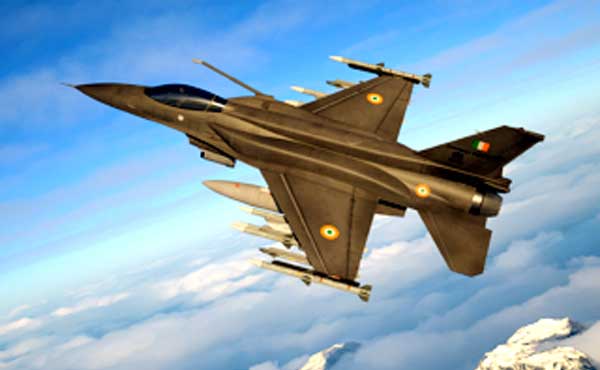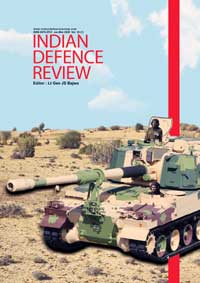
Indian Defence Review exclusive email interview by Col Danvir Singh – Associate Editor with William L. Blair, Vice President & Chief Executive – Lockheed Martin India
Lockheed Martin is bidding to supply 114, F21 to Indian Air Force. You say it is going to be a win-win situation for both the countries, how?
We are committed to strategic, long-term international defense partnerships with India and hope to strengthen and grow our relationship with India as part of an unprecedented F-21 fighter aircraft partnership for India, from India. Lockheed Martin is the world’s preeminent leader in fighter aircraft development, manufacturing, production and sustainment. India’s integration into this robust fighter ecosystem via an F-21 selection would result in India being at the epicenter of a USD $165 billion market, with future opportunities to expand its footprint through further developing indigenous capabilities and global supplier relationships.
The F-21 will truly be a game-changer for the Indian Air Force, Indian industry and India-US strategic ties. We are confident the F-21 is the best solution to meet the Indian Air Force’s capability needs, provide Make in India industrial opportunities, and accelerate India-US cooperation on advanced technologies, including but not limited to fighter aircraft.

Col Danvir Singh – Associate Editor interacting with William Blair – VP & CEO of Lockheed Martin India.
The F-21 has unique capabilities including, an advanced APG-83 Active Electronically Scanned Array (AESA) radar, which has detection ranges nearly double that of previous mechanically scanned array radars and the ability to track and attack more targets with higher precision; an Advanced Electronic Warfare (EW) System, developed uniquely for India, that provides enhanced survivability against ground and air threats; Long-Range Infrared Search & Track (IRST), enabling pilots to detect threats without getting detected; Triple Missile Launcher Adapters (TMLAs) allowing the F-21 to carry 40 percent more air-to-air weapons; and a Dorsal Fairing enabling increased growth capacity and indigenous systems integration in the future.
The F-21 is also the only fighter in the world with both probe/drogue and boom aerial fueling capability. This, along with Conformal Fuel Tanks (CFTs), delivers greater range penetration and loitering staying power to the Indian Air Force. The F-21 delivers an advanced single-engine, multi-role fighter at the most optimal Life Cycle Cost for the Indian Air Force with the longest service life of any competitor – 12,000 flight hours.
Simply put, the F-21 goes further, faster and stays longer than the competition – all at the most optimal Life Cycle Cost for the Indian Air Force. Whether you’re talking about battlefields or budgets, the F-21 is the clear choice for India.
How would technology of 70s compete with the modern technologies of the millennia fielded with Dassault, Eurofighter, Gripen E and MIG 35?
The F-21 will meet or exceed all of India’s performance, capability and advanced technology requirements. We are committed to offering superior engine matrix, electronic warfare system and weapons carrying capacity. It will also have a modern cockpit and significant ability to synthesise information. These are unique capabilities that we are not offering to other countries in the world. Additional details about the F-21 remain competition-sensitive and India has not yet issued formal requirements via a Request for Proposals (RFPs); we will share more details as the procurement process moves forward.
While it is inappropriate for us to compare specific capabilities, we are confident that the F-21 will give India a significant edge with greater standoff capability, greater staying power with less fuel burn, and network data linking capabilities across all platforms. Additionally, the F-21 is designed to operate across over 60 air force stations in India. No other company has the experience in next-generation technologies, including but not limited to fighter aircraft, Lockheed Martin can offer to India. We designed, developed and produced the world’s first operational stealth aircraft, the F-117, and the world’s only two current operational 5th Generation fighters: the F-22 and F-35.
What are those major upgrades in F21 when compared to the F-16 block 70 that sets F21 apart and world class?
The F-21 aircraft has been designed keeping in mind, the unique needs of the Indian Air Force. While aircraft structure may look familiar, the differences between the F-21 and F-16 become clear when looking at the unique capabilities of the F-21 including an advanced APG-83 Active Electronically Scanned Array (AESA) radar, an Advanced Electronic Warfare (EW) System, Long-Range Infrared Search & Track (IRST) and Triple Missile Launcher Adapters (TMLAs).
The APG-83 AESA radar has detection ranges nearly double that of previous mechanically scanned array radars and the ability to track and attack more targets with higher precision. The Long-Range Infrared Search & Track (IRST), enables pilots to detect threats without getting detected. Triple Missile Launcher Adapters (TMLAs) allow the F-21 to carry 40 percent more air-to-air weapons.
Additionally, the F-21 also comes with a Dorsal Fairing which enables increased growth capacity and indigenous systems integration in the future. The F-21 is also the only fighter in the world with both probe/drogue and boom aerial fueling capability. This, along with Conformal Fuel Tanks (CFTs), delivers greater range penetration and loitering staying power to the Indian Air Force.
When you say F21 will have greater standoff capability, greater staying power with less fuel burn, and network data linking capabilities across all platforms”, what exactly it means when compared to your competitors?
While it is not appropriate for us to comment on specific capabilities of the competition, we believe that an F-21 partnership with us will benefit India given that the offer brings immense Make in India opportunities, enhanced capabilities and cost-effectiveness.
The active electronically scanned array radar is projected to be the game changer, can you elucidate?
The advanced APG-83 Active Electronically Scanned Array (AESA) radar has detection ranges nearly double that of previous mechanically scanned array radars and the ability to track and attack more targets with higher precision. The APG-83 radar delivers greater situational awareness, flexibility and quicker all-weather targeting. The AESA radar is also being integrated with a new active and passive internal electronic warfare system, which incorporate a new fully Digital Radar Warning Receiver (DRWR) designed to interface with the APG-83 radar.
Please describe what operational gap you feel can be filled by F-21 now that India is inducting Rafale aircraft into its fleet?
The F-21 delivers an advanced single-engine, multi-role fighter at the most optimal Life Cycle Cost for the Indian Air Force, with the longest service life of any competitor – 12,000 flight hours. The F-21 goes further, faster, and stays longer than the competition. The F-21 will meet all of India’s performance, capability and advanced technology requirements, and provide unmatched opportunities for Indian companies of all sizes and suppliers throughout India. The F-21, in concert with the Rafale and Tejas, will provide an operational gap filler and will be a game-changer for the Indian Air Force, Indian industry, and India-U.S. strategic ties.
Lockheed Martin has a large portfolio of businesses. How are you leveraging the breadth of your businesses to enhance the F-21 offering?
Indeed, Lockheed Martin has a wide span of capabilities across our four business units, Aeronautics, Rotary and Mission Systems, Missiles and Fire Control, and Space, and given our commitment to India, we bring to bear all of them to supporting our Indian customers’ missions. We have been investing in local industry and manufacturing here since 2010, even in advance of the launch of “Make-in-India” which has provided further impetus to our plans.
We have a joint venture with Tata Advanced Systems in Hyderabad which produces major aerostructure components for the C-130J Super Hercules transport aircraft. This is the sole supplier of these components to Lockheed Martin and is an integral part of our global supply chain.
Our other joint venture in Hyderabad is between Tata and Sikorsky Aircraft Corporation. This Joint Venture manufactures components for the S-92 commercial helicopter and is also fully integrated into the global supply chain. Our understanding and engagement with the Indian aerospace and defense ecosystem, and of user requirements, offers us the critical advantage of being able to rapidly and efficiently realize our blue-print for the F-21 offer.
Lockheed’s announcement that it would shift the F-16’s entire production chain to India and manufacture the jet fighter jointly with Tata Advanced Systems Limited. Has the location been identified for setting up this plant?
Building fighter wings in India is a natural next step that builds on our successful partnerships with Tata on the C-130J airlifter and S-92 helicopter. This is a strategic business decision that reflects the value of our partnerships with India and the confidence we have in Tata to this type of advanced defense manufacturing work. We will be co-producing the same through our Joint Venture with Tata in Hyderabad.





